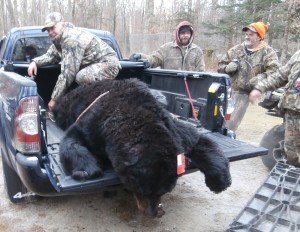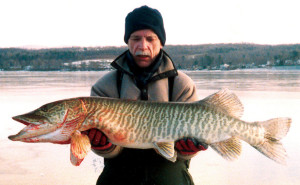This year is the first year that black bear could be hunted during the two week shotgun deer hunting season which ran from November 30 to December 12. This is in addition to the two other bear hunting seasons; the first season ran from September 8 to September 26 and the second from November 2 through November 21. The additional hunting season is the latest tool that the Department of Fisheries & Wildlife (DFW) has employed to try to manage the rapidly growing bear population statewide.
In his December 10 report to the Berkshire County League of Sportsmen, DFW Western District Manager Andrew Madden reported that preliminary harvest numbers of black bear taken during the two week shotgun deer hunting season statewide should be about 45. They may still have some check stations that haven’t reported in yet, but he doubts that the number is likely to change by more than a few bears. He predicts that the final number will probably be between 45 and 50.
We probably shouldn’t expect such high numbers every year. This year’s warm weather was undoubtedly a factor in the harvest totals. The bears were probably still actively foraging for food and had not yet settled into their dens for their long winter sleeps.
The final numbers for the September and November bear hunting seasons have not yet been released by DFW for either the state or western district. The total statewide bear harvest for 2014 was 240 with 78 of them coming from Berkshire County. *****
In his report, Madden also stated that a preliminary look at Western District check stations indicated a good first week of shotgun deer season with numbers up slightly from last year and good quality deer being checked. This is in spite of the lack of snow which usually affords better tracking conditions.
The following are some of the larger deer taken in the Western District. Included are the hunters’ last names, dressed out deer weights and towns where the bucks were taken: Wright – 196 lbs, Cheshire; Salvatore – 187 lbs, West Stockbridge; Majchrowski – 182 lbs, Dalton; Turner – 190 lbs, Hancock; Voudren – 190 lbs, Russell; Thomas – 194 lbs, Blandford and Gaudette – 202 lbs, Sandisfield. Gaudette’s deer was a 10 pointer.
The live weights of all of the above deer were undoubtedly over 200 lbs. Although not a true scientific measurement, if you apply the formula of field dressed weight x 1.25 you should come up with an approximate live weight of a deer. If one applies that formula to Gaudette’s deer, then the live weight was probably about 250 lbs.
While we are on the subject of deer weights, let’s carry it a step further and try to figure out the realistic venison yield. How many times have we heard of people accuse the deer processor of not giving back all the meat. Well, consider the following.
One adult bucks weighing over 160 lbs, one must deduct 9% of its weight which represents the hide; 11.7% is bone and some percentage representing the blood. Then one must consider the part of the meat that has been damaged by the bullet or improper field dressing. A neck shot has very little ideal meat ruined, whereas a deer shot in the loin or hind quarter area has more of the ideal meat ruined.
According to University of Wisconsin research, a mature buck weighing 165 pounds field-dressed would ideally yield 83.08 pounds of boneless meat and realistically yield about 58 pounds of good meat. Information came from http://www.butcher– packer.com and http://askthemeatman.com websites.. *****
Looking for a new project for your man cave this winter? Have you thought about taking up fly tying but didn’t know where to start? Well the Taconic Chapter of Trout Unlimited is once again hosting a fly-tying event this afternoon. The event is free and open to all TU members and their friends. It will be an informal gathering with members bringing in their own vises and tying materials. They expect to have a few extra sets available for those just curious about tying. This is a great opportunity to learn about fly tying and to exchange patterns and ideas. They will gather in the lounge at the Wahconah Country Club on 20 Orchard Road, Dalton from 2:00 to 6:00 PM. Refreshments can be purchased at the Club. If interested contact Henry Sweren at hsweren8@aol.com. *****
The Stockbridge Sportsmen’s Club will have youth archery sign ups Saturday, January 2, 2016 in the archery range from 8:00 to 10:00 AM. You can also download applications from their website www.stockbridgesportsmansclub.org. The cost is $40 per child and you do not have to be a member of the club. They will shoot the following 10 Saturday mornings. For more information, call Mike Buffoni at 413-323-7703. *****
On Sunday, January 17, Avid Sport on 1201 West Housatonic Street, Pittsfield will be holding a Firearms Safety Course which allows you to apply for your FID card or Pistol Permit. The class is usually limited to 9 and you are required to prepay to lock in a seat. The cost is $100. For more information, call 413-997-3600.
If you live in Northern Berkshires, there is another firearms safety course on the same day in North Adams. Dan Peck, NRA and Massachusetts State Police Certified Instructor will be teaching that course. For location, hours and more information, call 413-663-4896. *****
The DFW Western District office has a new biologist. His name is Nate Buckhout from East Hampton, MA. An Air Force veteran, Nate received his BA from the United States Air Force Academy and his Masters degree in Wildlife Conservation from UMASS Amherst. He filled Tony Gola’s position who retired earlier this year.


